FUNCTION OF CHROMOSOMES
INTRODUCTION:
Chromosome ( chroma : colour ; soma: body)can be defined as a strand of DNA molecule associated with proteins. Chromosomes are the hereditary vehicles found in the nucleus of a cell. The chromosomes contain genes, thus,they carrier of heredity. Genes help in transferring characteristics from parents to the offsprings which are situated in the form of chromosomes.
The genes are composed of DNA and proteins. DNA ( deoxyribonucleic acid) functions as the genetic material. It forms the chemical basis of heredity. A gene is a segment of DNA that codes for the synthesis of a specific protein that controls the expression of a particular characteristic in an individual. Thus, in the chromosome, the gene is the basic hereditary unit of an organism.
IMPORTANT TERMS RELATED TO CHROMOSOME
1)CHROMATIN NETWORK: It refers to the network of chromosomes present in a highly diffused and uncoiled form in the interphase nucleus.
2)CHROMATID: One of the two identical parts of a chromosome after its duplication is known as chromatid. During cell division, two sister chromatids make up a chromosome. The sister chromatids of a chromosome are joined together by a single centromere.
3)CENTROMERE: It is a constricted region of a chromosome. During cell division,a chromosome consists of two chromatids. The two chromatids of a chromosome are attached at the centromere. Also chromatids are attached to the spindle fibres at the centromere region.
STRUCTURE OF CHROMOSOME
Chromosomes carry genetic information and so are called the hereditary material of a cell. After it was known that the genes, the unit of heredity are present on the chromosomes, scientists began with a detailed study of the structure of chromosomes. The structure of chromosomes are different in prokaryotic cell as-well-as eukaryotic cell.
| PROKARYOTES | EUKARYOTES
|
| *They have only one chromosome.
*Its organization is simple and consists of only a circular DNA molecule associated with a few proteins *The single circular molecule of DNA is much smaller in comparison to a single chromosome of a eukaryote. *E.g.bacteria |
*They have a number of chromosomes.
*The chromosomes are much more complex in structure and differ widely in appearance. *Each chromosome is composed of a long molecule of DNA and has a much more number of basic proteins as compared to that of prokaryote. *The chromosomes occur in pairs, known as homologous chrosomes. *E.g.all plants and animals. |
CHROMOSOME NUMBER
All individuals of any specific species, the number of chromosomes is fixed and they have equal number of chromosomes. The number of chromosomes in the somatic cells of higher plants and animals is known as the diploid number represented by 2n .In gamete( sperms and eggs), it is known as the haploid number is represented by n. The chromosome number of some plants and animals is given.
| NAME OF THE ORGANISM | CHROSOME NUMBER |
| Human being | 46 |
| Chimpanzee | 48 |
| Dog | 78 |
| Donkey | 62 |
| House fly | 12 |
| Corn(maize) | 20 |
| Garden pea | 14 |
| Onion | 16 |
STRUCTURE OF A EUKARYOTIC CHROMOSOME
The eukaryotic chromosomes can be best studied at the metaphase stage of the cell division.
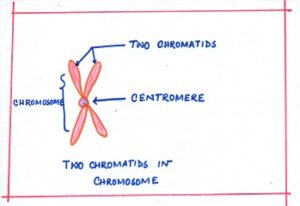
Fig#1 two chromatids in one chromosome
*At metaphase, the chromosomes are condensed to the maximum. Under light microscope,each chromosome appears in the form of two distinct chromatids attached to each other by a centromere.
*The chromosomes at this stage can be readily counted and distinguished from each other.
*The chromosome reveals a distinct pattern and have a specific size,shape and position of the centromere.
* At this stage karyotyping is done. A karyotyping is the systematic arrangement of chromosome according to their size shape.
DIFFERENT SHAPES OF CHROMOSOMES
Each chromosome has a condensed and constricted region called the centromere.The position of centromere is specific to a chromosome and varies in different chromosomes. The centromere divides a chromosome into two parts,each one is called an arm of the chromosome.
Depending on the position of centromere, chromosome acquires different shapes. Accordingly , chromosomes have been classified into the following four types:
i)Telocentric
ii)Acrocentric
iii)Submetacentric
iv)Metacentric
Features of different types of chromosomes ( why are chromosomes called hereditary vehicles)
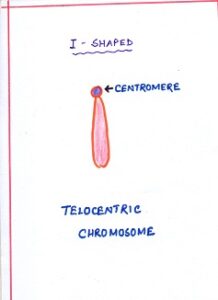
Fig#2 telocentric chrosome
i)TELOCENTRIC: Rod-like chromosomes as the centromere is present at the proximal end.
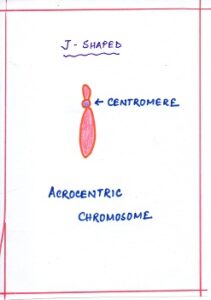
fig#3 acrocentric chrosome
ii)ACROCENTRIC: Appears rod-like in shape. Centromere is present near the extreme end and so one arm is very long and one very short.
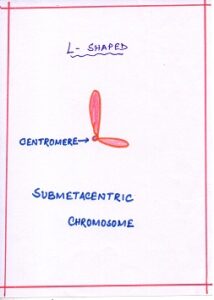
Fig#4 submetacentric chrosome
iii)SUBMETACENTRIC: J or L shaped as the centromere is slightly displaced from the centre and so both the arms are unequal.
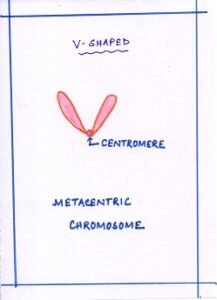
Fig#5 metacentric chrosome
iv)METACENTRIC: V-shaped as the centromere is present right in the centre, and so both the arms are equal.
CHROMATIN- AN OVERVIEW
*The chromatin material consists largely of two strands of deoxyribonucleic acid(DNA) and proteins(mainly histone).
*Each chromosome consists of a number of genes. For example,a human chromosome may contain thousands of genes.
*Each gene is present at a specific position on a chromosome called locus.
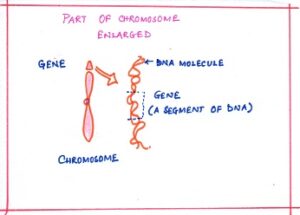
Fig#6 position of gene and DNA in chromosome
*Each chromosome is made up of a highly coiled DNA molecule which has a number of genes present along its length.
*A gene is a short segment of DNA.
In overall part of the chromosome DNA forms about 40% of the chromosome while 60% of chromosomes are formed by histone protein. Along the lengthwise of chromosome DNA contains negative (-VE) part and positively charged histones bound the molecule. This DNA-histone complex is called chromatin. It is shown that the DNA helix combines with groups of eight histone molecule to form a structure known as a nucleosome. It has an appearance of beads on a string. In a human cell, there are about two million nucleosome among 46 chromosomes.
STRUCTURE OF DNA- DEOXYRIBONUCLEIC ACID
DNA is the hereditary material of a cell a sit contains the genetic information. DNAis the most important constituent of a chrosome.
CONTRIBUTION OF SCIENTISTS TOWARDS THE DISCOVERY AND STRUCTURE OF DNA
| NAME OF SCIENTIST | YEAR | CONTRIBUTION |
| 1)Frederich Meisher | 1869 | *First scientist to isolate DNA from the nucleus of the pus cells.
*Gave the name nuclein or nucleic acid because of its acidic nature. |
| 2)Rosalind Franklin | 1951 | *Based on X-ray defraction studies of DNA, showed that it has a helical structure. |
| 3)J.D.Watson and FHC Crick | 1953 | *Gave the famous thre dimensional double-helical model of DNA
*They were awarded Nobel Prize for this in 1962. |
COMPONENTS OF A DNA MOLECULE
A DNA molecuele is a large molecule ,a macromolecule consisting of million of nucleotides. Hence, it is also called a polynucleotide.
Each nucleotide consists of three components:
a)A pentose sugar- A deoxyribose sugar
b)A nitrogen base
c)A phosphate group
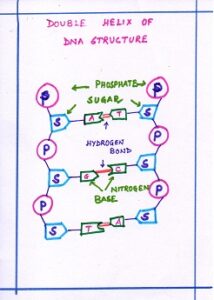
Fig#7 double helix of DNA
Together they form a nucleotide.
The nitrogen bases are of two types- Purines and Pyrimidines.
There are two types of purines: Adenine (A) and Guanine(G)
There are two types of pyrimidines: Cytosine(C) and Thymine(T)
WATSON AND CRICK MODEL OF DNA
Watson and Crick gave the famous double-helical structure of DNA for which they were awarded the Nobel Prize in 1962.
*DNA molecule consists of two polynucleotide chains or strands which are long, parallel and spirally coiled around the same axis.
*These chains form a double helix like a spiral staircase.
*The sugar and phosphate units form the backbone of the polynucleotide chains and the paired nitrogenous bases form the centre.
*Both the strands are joined together by weak hydrogen bonds present between the nitrogen bases of two strands.
*Pairing between the nitrogenous bases is such that, always a purine pairs with a pyrimidine, specifically(WHAT ARE IN CHROMOSOME)
*ADENINE PAIRS WITH THYMINE (TWO HYDROGEN BONDS BETWEEN THESE)
*CYTOSINE PAIRS WITH GUANINE (THREE HYDROGEN BONDS BETWEEN THESE)
Such a base pairing is called complementary pairing.
In a DNA molecule, the purines and pyrimidines are equal in number.
*The double helix is like a spiral staircase. It takes a complete turn after 34Å (angstrom).
*The width of the DNA molecule is 20Å (angstrom).
*The nucleotides in a helix are joined together by phosphodiester bonds.
UNIQUE FEATURES OF HUMAN CHROMOSOMES ( WHAT ARE IN CHROMOSOME)
In human males, one sex chromosome is smaller than the other. They have one larger chromosome which is the X chromosome and another is smaller which is known as the Y chromosome.. Thus, the condition in the male can be represented genotypically as XY and in female it is XX. The sex chromosome of human females are described as HOMOMORPHIC and that of human males are HETROTROPHIC. Human females can produce only one type of gametes named as (X) and (X) and are this condition is known as homogametic. The human male can produce two types of gametes (X) and (Y) and this condition is called heterogametic.
————————————————————————————————————————————-